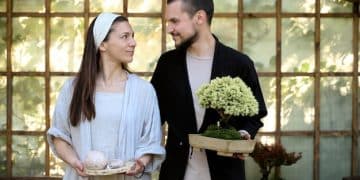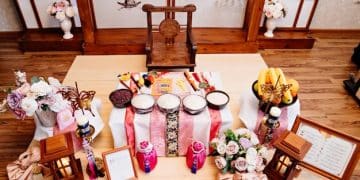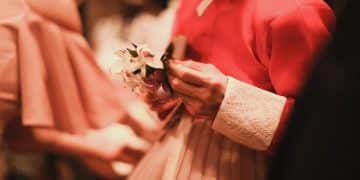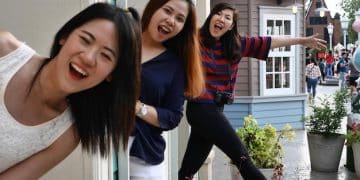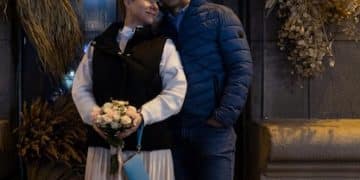Korean Wedding Traditions: A Guide for Guests in the US
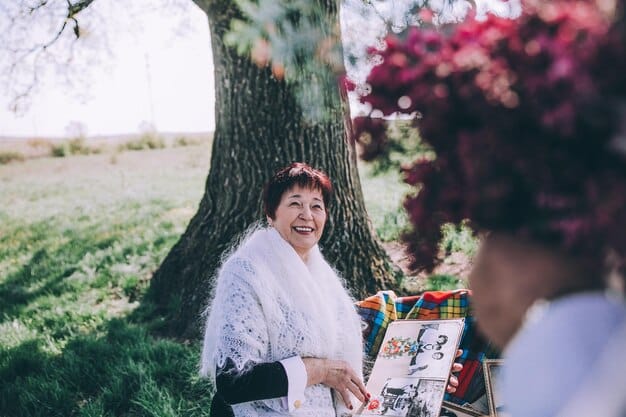
Korean wedding traditions blend ancient customs with modern sensibilities, creating unique and memorable celebrations for couples and their guests in the US.
Attending Korean wedding traditions: what to expect at a Korean wedding in the US, can be a truly enriching experience, offering a glimpse into a vibrant culture. However, understanding the customs and etiquette involved can help you navigate the celebration with grace and appreciation.
Understanding Korean Wedding Attire and Customs
Korean weddings are known for their elegance and symbolism, often showcasing traditional attire and customs. Understanding these elements can enrich your experience as a guest, allowing you to appreciate the cultural significance behind each ritual.
Traditional Hanbok: The Wedding Attire
The Hanbok is the traditional Korean dress, characterized by vibrant colors and simple lines. Both the bride and groom, as well as members of their families, often wear Hanboks during the wedding ceremony and reception.
- Bride’s Hanbok: Typically includes a green or red chima (skirt) and a jeogori (jacket) adorned with intricate embroidery.
- Groom’s Hanbok: Usually consists of a baji (trousers), a jeogori (jacket), and a durumagi (outer coat).
- Family Attire: Parents of the bride and groom often wear Hanboks in specific colors to represent their families.
Guests are not expected to wear Hanboks, but dressing respectfully is appreciated. Formal attire, such as suits for men and dresses for women, is generally appropriate.
Key Customs to Expect
Several key customs are integral to Korean wedding ceremonies. Being aware of these traditions will help you understand the significance of the event. Understanding the **Korean wedding traditions** makes you a respectful and considerate guest.
- Jeonnyehon (전통혼례): The traditional Korean wedding ceremony held in a hanok (traditional Korean house) or a similar venue.
- Pyebaek (폐백): A ceremony where the bride offers tea to the groom’s parents, receiving blessings and words of wisdom.
- Hapgeunrye (합근례): The ritual of drinking wine from the same cup, symbolizing the union of the bride and groom.
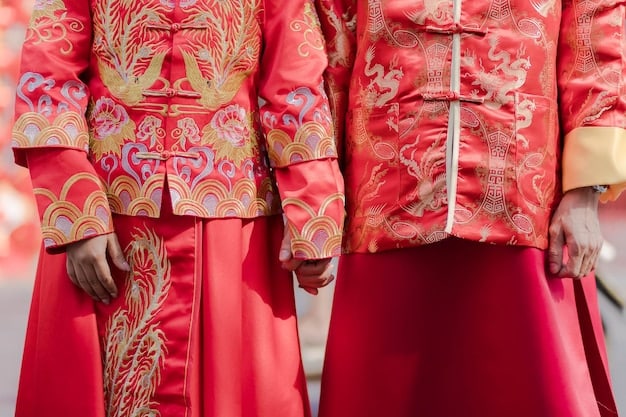
By familiarizing yourself with these traditional elements, you can approach a Korean wedding with a deeper understanding and appreciation for the cultural heritage it represents. This understanding not only enriches your experience but also showcases your respect for the couple and their families.
The Wedding Ceremony: What to Anticipate
The wedding ceremony is the heart of the celebration, blending Korean traditions with modern influences. Being prepared for the flow of events can help you fully enjoy this significant moment.
Arrival and Seating
When you arrive at the wedding venue, you will typically be greeted by the families of the bride and groom. It’s customary to offer your congratulations and express your well wishes.
- Seating Arrangements: Guests are usually seated according to their relationship with the couple. Family members often sit closer to the front, while friends and colleagues may be seated further back.
- Guest Book: Be sure to sign the guest book upon arrival, leaving a short message for the newlyweds.
- Gift Presentation: If you’re bringing a gift, present it to the designated person or place it on the gift table.
The Ceremony Unveiled
The actual ceremony can vary depending on the couple’s preferences and religious beliefs, but some elements are quite **Korean wedding traditions** that typically remains consistent.
- Processional: The ceremony usually begins with the entrance of the mothers, followed by the groom and finally the bride.
- Vows and Rings: The couple exchanges vows and rings, symbolizing their commitment to each other.
- Traditional Rituals: Depending on the couple’s preference, the ceremony may include traditional Korean rituals like bowing to parents or a tea ceremony.
The ceremony often concludes with the couple exiting the venue, followed by applause and well wishes from the guests. Be ready to capture photos and share in the couple’s joy.
Navigating the Reception: Food, Festivities, and Fun
The reception is a time for celebration and socializing, with delicious food and various forms of entertainment. Knowing what to expect can help you fully participate in the festivities.
Feasting on Korean Delights
Food is a central part of any celebration, and Korean wedding receptions are no exception. You can look forward to a delicious spread of traditional Korean dishes and international cuisine.
- Buffet or Sit-Down Meal: Depending on the couple’s preference, the reception may feature a buffet-style meal or a formal sit-down dinner.
- Traditional Dishes: Look out for classic Korean dishes like bulgogi (marinated beef), japchae (glass noodles), and kimchi (fermented vegetables).
- Dietary Considerations: Be sure to inquire about dietary options if you have any allergies or preferences.

Enjoying the Entertainment
Korean wedding receptions often include various forms of entertainment, ranging from live music to karaoke sessions. Embrace the opportunity to participate and have fun.
- Live Performances: Some weddings feature live bands or traditional Korean dancers.
- Karaoke: Karaoke is a popular form of entertainment at Korean weddings. Don’t be shy – grab a microphone and sing your heart out!
- Games and Activities: Engaging games and activities are often organized to get guests involved and create a festive atmosphere.
The reception is a time to celebrate the couple’s union, enjoy delicious food, and revel in the joyous atmosphere. Be sure to mingle, dance, and create lasting memories.
Gift-Giving Etiquette: Expressing Your Congratulations
Giving a gift is a traditional way to express your congratulations to the newlyweds. Understanding the appropriate etiquette can help you choose a thoughtful and meaningful present.
Monetary Gifts: The Norm
In Korean culture, it’s customary to give a monetary gift to the couple. The amount you give depends on your relationship with the bride and groom and your financial means.
- Presentation: Place the money in a crisp, new envelope and write your name on it. White envelopes are typically used for this purpose.
- Amount: A general guideline is to give between $100 and $300, depending on your relationship with the couple. Close friends and family members may give more.
- Timing: Present the envelope to the designated person or place it on the gift table upon arrival at the wedding.
Alternative Gift Ideas
While monetary gifts are the norm, you can also consider giving a traditional wedding gift, such as:
- Home Appliances: Practical gifts for the couple to use in their new home.
- Gift Certificates: Gift certificates to department stores or restaurants are always a welcome option.
- Personalized Gifts: Consider giving a personalized gift, such as a framed photo or an engraved item.
Whether you choose to give a monetary gift or a traditional present, make sure it’s given with sincerity and heartfelt congratulations. This thoughtful gesture will surely be appreciated by the couple.
Communicating and Connecting: Building Relationships
Korean weddings are not just about the ceremony and reception; they’re also about building relationships and fostering a sense of community. Embracing the opportunity to connect with others can enhance your experience.
Breaking the Ice
Korean weddings often bring together family, friends, and colleagues from various backgrounds. Take the initiative to introduce yourself and strike up conversations with other guests.
- Introduce Yourself: Approach other guests with a friendly greeting and introduce yourself.
- Ask Questions: Show genuine interest by asking questions about their relationship with the bride and groom.
- Share Stories: Share a funny or heartwarming story about the couple to break the ice and create a connection.
Communicating Respect
In Korean culture, showing respect for elders and superiors is highly valued. Be mindful of your interactions and communication style throughout the wedding celebration.
- Use Honorifics: When addressing elders or individuals in positions of authority, use appropriate honorifics (e.g., “sunbae-nim” for senior colleagues).
- Bow Respectfully: Bow slightly when greeting someone older or more senior than you.
- Listen Attentively: Practice active listening and show respect for their opinions and perspectives.
By communicating respectfully and taking the time to connect with others, you can create meaningful relationships and make lasting memories at the Korean wedding. Respect and showing gratitude for the **Korean wedding traditions** will always be well received.
Post-Wedding Etiquette: Continuing the Celebration
The wedding day may be over, but your role as a well-wisher extends beyond the celebration. Following appropriate post-wedding etiquette can help you maintain positive relationships with the couple and their families.
Expressing Gratitude
After the wedding, take the time to express your gratitude to the couple for inviting you to share in their special day. This can be done through a thank-you note, a phone call, or a personal visit.
- Thank-You Note: Write a heartfelt thank-you note expressing your appreciation for the invitation and congratulating the couple on their marriage.
- Personal Visit: If possible, visit the couple in person to offer your congratulations and well wishes.
- Gifts: If you received a wedding favor, be sure to express your gratitude for the thoughtful gesture.
Staying in Touch
Make an effort to stay in touch with the couple after the wedding, whether it’s through social media, email, or occasional phone calls. Maintaining these connections can strengthen your relationship with the newlyweds.
- Social Media: Follow the couple on social media and engage with their posts and updates.
- Email: Send the occasional email to check in and see how they’re doing.
- Phone Calls: Schedule regular phone calls to catch up and maintain a personal connection.
By following these post-wedding etiquette guidelines, you can demonstrate your continued support and well wishes for the couple’s happiness. The **Korean wedding traditions** are not just a one day celebration, but the start of a new chapter for the happy couple.
| Key Point | Brief Description |
|---|---|
| 🎎 Hanbok Attire | Traditional Korean dress worn by the bride, groom, and family. |
| 🍵 Pyebaek | Tea ceremony where the bride offers tea to the groom’s parents. |
| 💰 Gift Giving | Monetary gifts are customary, presented in a white envelope. |
| 🎤 Karaoke | Popular form of entertainment at Korean wedding receptions. |
Frequently Asked Questions
▼
Formal attire is appropriate. Guests don’t typically wear Hanboks, but dressing respectfully is appreciated. Suits for men and dresses for women are generally suitable.
▼
The amount depends on your relationship with the couple. A general guideline is between $100 and $300. Close friends and family may give more.
▼
Only if your invitation explicitly states that you can bring a guest. Otherwise, it’s best to attend alone to respect the couple’s arrangements.
▼
Inform the couple or their family in advance about your dietary needs. Korean weddings often offer a variety of dishes, so they may be able to accommodate you.
▼
The Pyebaek is a traditional ceremony where the bride offers tea to the groom’s parents, who then offer blessings and advice to the newlyweds.
Conclusion
Understanding the nuances of Korean wedding traditions can significantly enhance your experience as a guest at a Korean wedding in the US. By embracing these cultural customs and showing respect for the couple and their families, you can contribute to a celebration filled with joy, love, and lasting memories.

